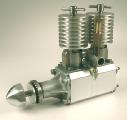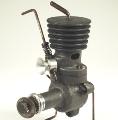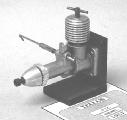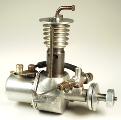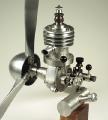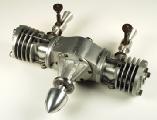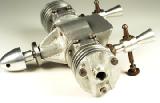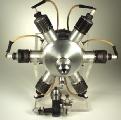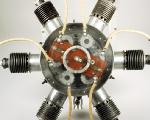WATZIT?!
Model Engines of Unknown Origin
Page 1
Last update: May 21, 2006
Click on images to view them in larger size and more detail.
An ED Based In-line Twin
Bert Streigler has dug this one up. Here are his observations:
My old friend, Ray Strinati, sent the subject engine to me and it just arrived. He says it was built in 1970, but he cannot remember who built it. As you look at the pics, it is obvious that the cylinders are ED 2cc, MK 1 at the rear and MK 2 at the front! The case is built in three pieces with the center carrier sandwiched between the rear case and the front. The whole mess is held together by long tie bolts that further act as the radial mounting bolts. The front crankshaft is ED 2cc with the crankpin shortened and a dowel pin inserted in the hollow crankpin to act as the "driver" for an aluminium disk that is attached to the stub shaft in the center carrier. There is a large O ring between the disk and the carrier that is supposed to act as a seal, I suppose, but I don't see how it could work very well. The stub crank that drives the rear piston is apparently a cut off ED shaft with a large square on the front where it goes into the aluminium disk used as a drive disk. The drive disk is staked to the shaft - you know, hammered in place and staked with a center punch. Ah, whoever built this is my kind of guy! Oddly, though, the whole thing seems to work well enough.
The crankcase is beautifully polished and might have been filed to shape! Much of the interior of the case was shaped with a hand grinder, with very little lathe work evident. The long thru bolt holes were evidently drilled on a drill press. The front holes are right, but they are not in the same place at the rear. Having said all that, I admire the person who built this engine. He must not have had very much equipment to work with but he strove onward regardless. I am not jesting about the engine as it is really pretty damn nice and it feels good. I have not tried to run it and I may not as I am concerned about that aluminium drive disk driven by a 1/8" dowel pin, but the builder was ahead of his time and his finished product is a real keeper. I would have been proud of it. I am not proud of the attached pics, but the Olympus is back at the factory for a software upgrade and the old Nikon does not like my light arrangement. The pics were taken in a hurry.
Here's another from Bert. Subsequently, we've managed to identify the engine, but it is such a good looking example with such unusual features that it's certainly worth entering here. Initially, Bert said:
You might be getting tired of all these weird engines, but here is another. David, since you are the sideport guru, you should like this one. The builder must have been quite courageous since the thing has a sand-cast magnesium case. Close examination shows some faint remains of an alodine finish. Also notice that the intake is about 10 degrees off to starboard and that is intentional since the boss is cast in. There is a single bypass port at the rear and there are two exhaust ports. Typical of a Czech engine, the contra piston is aluminium and the piston has a screwed-in aluminium wrist pin carrier. The engine has been run a fair amount, but the steel rod is a little loose so I have not tried it out. It has excellent compression and good fits. My contact in the Czech Republic could not identify it, or maybe "would not" identify it. After he saw the pic he promptly offered to trade for it!
Tim (Model Museum and ECJ Editor) Daniel nailed that last one right away - it is a 1948 Machacek, so there! Now when Tim himself is stumped, you know you've got a rare one, so anyone know anything about this engine? (Hint: It's not a Tellus). Tim spotted it in a display at the AMA museum (Muncie, Indiana) and asks:
Herewith is one that really caught my eye - cause I like the little ones. They had it listed as a Tellus - David-Andersen type - but we know it isn't a Tellus. It is little, .5cc and is a diecast case, matte finish - there are things that almost look D-A about it, but I had never heard of a .5cc D-A. I have all three models of the 1cc Satellitt D-A. If they made a .5 - I WANT ONE!!! Can any of you gentlemen identify this little gem? I am convinced it is someone's production item - Unless someone like our friend Ken just makes up dies and casts one engine!!!! Let me know if you have ever seen one like this. No - No Markings on it.
...with absolutely no disrespect intended to any international visitors This British home-built I will call Froggie Topsy, for obvious reasons. It is 1.5cc with a .444 bore and a stroke of .600. The shaft looks like it came from a Hallam engine. The case appears to be turned and filed from the solid! It has a Mills-like cutout on the needle valve body. The intake looks like it came from an early Frog. It was pretty well made and shows signs of having run a fair amount. I have not tried to run it as the cylinder has reverse taper and lacks compression. As received several years ago, it had no compression, but most of that was an ill-fitting brass contra piston which I replaced with a proper iron one. The shaft is bushed in bronze and it has a mild steel rod.
Here is an elegant little engine, very nicely made and very complicated. It is 2.2cc and came from the Frank Ehling collection. Ron Moulton sent the engine to Frank somewhere around 1956, but Ron cannot remember who made it or where it came from. Even the plug is home built with a mica insulator. Whoever built is is a steam man. The rotary valve has a small drilled hole to register with a similar hole in the case, a pretty typical steam type of inlet where the pressure is already outside the machine! It is timed to run clockwise. It had the spinner but not the prop blades. The blades are held in the hub by a single small screw! I hammered out the blades on my anvil with a 3 lb hammer and finished them on a belt sander. This is a very unusual little feller and it would be nice to know who might have built it. Maybe Ken or Tim will have an idea?
There was also an uncompleted opposed twin, 2.4cc, that was obviously made by the same fellow. It has a large "H" cast on top of each head, and is ringed with bronze rings. It was never finished completely. Rods are brass with tiny bolts holding on the caps. Again, nicely made. Both the twin and the single were fitted with 1/4 x 38 plug threads!
Initially, Bert did not send out pics of the twin, not wanting to clutter our mail boxes (as if!). Now as a total depraved loon where any twins are concerned, I was saved from having to do my best slavering grovel act by his next email:
Here is the little twin I mentioned in my other letter. After thinking about it, I thought I better send on some pics of it or Ron would have a fit. The first pic shows the thing right side up. The second shot shows it upside down, but is taken to emphasize the "H" cast into each head. Notice the bolt-on bypass covers and the "shelf" mount at the rear that has not been drilled for mounting holes. The timer runs off the shaft at the rear of the engine, but alas, there was no timer and the cam had not been cut on the shaft, which extends beyond the rear of the bearing for that purpose. Might make a reasonable project down the road, but in any case, it is a cutie. Or could have been.
It's always good to get to the bottom of some of life's little mysteries (Copyright (c), I'm sure, of the Micromumble Corporation). In this case, Bert had a major winf in relation to the two previous Watzits:
A couple of years or more ago I sent out two pictures of home built engines I had purchased from the Frank Ehling collection. Frank could not remember anything about them except that their transfer to him was arranged many years ago by Ron Moulton. There was a little single and a twin, both very well made, but the twin was unfinished. The single is 2.2cc and has a home built plug with a mica insulator. The plug is 1/4x38 TPI. The twin was without plugs, but was threaded to the same size, 1/4x38 and from that I assumed they were probably by the same maker. It turns out that I was right. By an odd set of circumstances, I now know who made these engines and when they were made.
During the effort to clean out George's stuff, I found two years of bound volumes of Aeromodeller, 1967 and 1968, which i promptly purchased. Last night I picked up the 1968 volume and simply flipped it open near the back as I usually browse a book backwards, that is from rear to front! To my astonishment, I found myself looking right at a picture of the little twin that I have! The very same engine. What must the odds be on something like this happening? I will quote the brief description found in the November, 1968 issue, "Rebirth of interest in twin cylinder engines (being made in U.S.A. and W. Germany) prompts us to print this photo of 2.5cc twin made long ago by G.W.McDonald of Lowick, Northumberland, in 1935 in fact! The 2-throw shaft is machined from solid steel. Con rods are Bronze and aluminium alloy with split big ends. Intended for coil ignition, the twin is now owned by Jim McCann." I measured the displacement at 2.4cc, close enough between friends.
Then I browsed on up through the issues and ran onto a pic of the little single! It is very nice and has the most complicated timer and choke controls I have ever personally seen, complete with little black, round knobs on each lever. Here is a quote from the article, "Above, not exactly new, but this 1934 spark ignition engine now with Jim McCann of Newcastle on Tyne was made by a Mr. McDonald and has rear disk induction, surely one of the first." Both of these engines were in Peter Chinn's "Latest Engine News" reports.
Now to some particulars. I did not know Mr. McDonald, but he was a fine machinist. The little twin was never completely finished, and since the pic was published in Aeromodeller someone threaded the shaft, made a spinner nut and prop drive washer, and added two intake tubes - probably off of Embee engines from the looks of them. All neatly done. No holes were ever drilled in the mounting plate and I would guess the timer was never made because there is no cam on the rear shaft and no sign anything was ever mounted on the bearing extension. Obviously, the engine had never been run, but it did have a bent rod on one cylinder because someone had reversed the head and the piston baffle hit the head. The rod was easily straightened since it was made of bronze. The tiny rod caps look like the ones on a car connecting rod, held in place with two really tiny screws ! All elegantly made. A close exam of the Aeromodeller pic shows the cylinder on that side installed inverted, with the exhaust on the wrong side, thus explaining the bent rod! It has cast aluminium cylinders with thin steel liners, and cast iron pistons with two bronze rings. AHA! McDonald was a steam man - little question of that as some steam thinking was also carried over to the single as I will discuss next.
The single is a work of art with it's jewel-like timer assy and it's little black knobs. There is no conventional prop driver washer, which is replaced instead with a three-bladed prop hub with a fitted spinner. The prop blades were held in place with a single, very small screw - not something I would want to be near when it was running. There were two crude wooden blades with the engine but these were done by someone other than the builder. How do I know this? The blades were set up to run counter clockwise, while the engine was actually built to run clockwise. Oddly, the rear rotor has only a small hole that registers with a like small hole in the backplate. Yet another illustration that McDonald was a steam man, used to valving rather high pressure gases. Look at the tiny mounting lugs with a single hole, and also look at the tiny screws holding the head and the cylinder flange in place. These are roughly equivalent to our current 0x80 screws! More evidence of steam thinking in my view.
This engine also shows no evidence of having been run. I hammered out the aluminium prop blades that you see in the picture. Did it on my 100 lb anvil with a two pound hammer, lots of cursing and lots of filing and sanding with wet paper. It is fitted with a lapped piston and is of straight forward construction.
The single must truly be one of the very earliest RRV engines if these dates are correct. I did not know Jim McCann and I am sure he is the one who supplied the dates. From the sound of it, he must have personally known Mr McDonald. Maybe Ken or Ron Moulton can come up with more info on these engines and the gentleman that built them. I have no doubt that the single could have been developed into a good performing engine with a few modifications but you can bet it will stay the way it is as long as I have it! I can take better pics now if anyone wants more info. This is the one and only 6-cylinder M@M Radial. When I got the thing, the entire front plate was missing, the "wiper" in the distributor was missing and I had no idea how the damn thing worked. The crank is geared to half "engine" speed with soft aluminium gears that you can see in the shot of the distributor, with no means of lubricating them. The cylinder/piston assys were all used 1940 versions and the whole thing is really 6 separate engines, each with its own crankcase and reed intake. A very careful examination of the aluminium gears revealed a scratch mark on each and corresponding marks on the large output shaft gear. If all of these were lined up, it became clear that the engine operated as three Opposed twins, which in turn fired in a radial manner, ie; twin 1, then twin 2 and then twin 3.
There were no points and no sign there had ever been a cam. There were, however, extra contacts in the distributor and I finally realized that the wiper also contacted the extra contacts as "points". There was also no indication of any way to mount the engine, and there was no good reason to use plexiglass in the rear of the timer. I concluded that this was a "proof of concept" engine, or maybe a "brag" engine for use at shows. It is mentioned in several collector's lists as having existed, and I got it from a very old ex employee and engineer that was with M@M when the doors where closed in 1940. If it had run, the soft aluminium gears would have probably failed on the first firing! Also, what in the world would you do with something like this in 1940? This is a BIG engine and would require electric starters that we did not have then. It is 1.8 cu. in. and with the prop running at half speed, I'm sure that it would require at least a 20" prop! I know the US guys have seen it, but I don't recall that any of you guys ever saw it in the MECA bulletin, so here are two
A Czech Oddity
Update: 2006-05-21
Fearless editor of ECJ, Tim Dannels, supplied the answer, but somehow it failed to get attached to the question for an extra special long time (the envelope please...) And the name is, "Machaech".
Tim's Delima
Froggy Topsy
 , Bert has yet another unusual engine. The "obvious" reasons he refers to below in selecting the name are the cylinder shape and fixing method are reminiscent of the early English Frog 100 and 150, while the venturi is similar to a design called the "Topsy" that appeared in Model Engineer many years back.
, Bert has yet another unusual engine. The "obvious" reasons he refers to below in selecting the name are the cylinder shape and fixing method are reminiscent of the early English Frog 100 and 150, while the venturi is similar to a design called the "Topsy" that appeared in Model Engineer many years back.
British Single Oddity
Don't you just love all the little levers and knobs at the back of this engine? Bert again:
British Twin Odity
Apparently from the same builder was an opposed (boxer) twin. The workmanship is beautiful. Where does this guy find all these things... Bert?
Mystery Solved: British Single and Twin
M&M Radial
Now this is not really a "Watzit", because we know exactly what it is! That said, if it ever escaped from a certain Texas cattle ranch, it would certainly rate under the watzit category anywhere else. I'll let Bert explain:
Mystery Sparkie
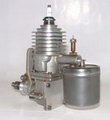
|
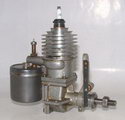
|
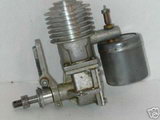
|
The origins of this one are a total myesery. ECJ editor, Tim Dannels took photos of it while attending the AMA convention in Ontario during 2004. It was then owned and shown to him by the late Jim Gerard, a Californian collector. Jim said he had no idea what it was. Neither did Tim—and that's saying something! It appeared next in July 2005 where it was offered for sale on eBay. There it was spotted (but not bought) by Roger Schroeder who supplied the picture on the right, captured from the auction.
With no real evidence whatsoever, I'd call it a one-off home-built, or prototype. The case and cylinder appear to be sand cast, with a certain Chunn flavour. The fuel tank looks like a pressed tin "spice" container with a well aged patina. The timer arm might be die cast—and from something else entirely—while the backplate looks like it has just been cut from flat plate. The unsightly solder flow on the needle suggests home-built too, though some commercial jobs fell down badly in this are too. And if you look closely at the timer spring, you'll notice a pattern of marks near the front edge. These look suspiciously like the pattern of wavy teeth on a "Junior" hacksaw blade, most of which have been ground away—though not having the engine to examine closely, I could be way out of line on this accusation.
There is no doubt that Tim's shots are of the same engine as that sold on eBay: observe the damage around the front mounting hole of the left-hand engine lug. None of this says that the current owner has made a bad buy. For all we know, it may run (although I'd guess it is destined for the display case) and it most likely dates back to the 30's or 40's. That was a time when many chose to build their own engines for a number of reasons: cost, availability, war-time austerity, or even for the enjoyment of doing it! In the unlikely event that anyone reading this can shed some light on this particular engine, or even give a positive ID to the thing used as the fuel tank, we'd be delighted to hear about it.
The Answer:
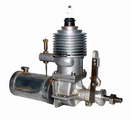
Time has a habit of increasing knowledge, and if you are lucky, wisdom too. Tim emailed his own answer to this one years later: they are the 1946 Apex .447 engines, originally offered as kit engines, but also actually sold as finished items too. The Apex Skylark is the best known of the group and then there was an Apex 120 which would pass for a bloated Forster Little Hercules .99 unless you looked real close. Now you know and the original guess of a "home-built" might be right—at least the new pic Tim supplied does not use a piece of Junior hacksaw blade as the timer spring!
